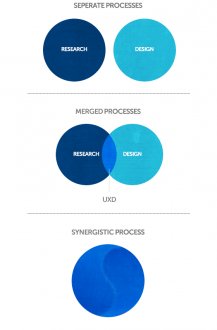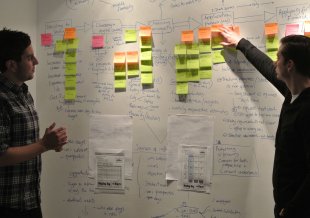

Translating insight and knowledge into meaningful interaction design
This article will focus on the actual 'shaping' or designing of meaningful interaction. Understanding what is actually meaningful to people in terms of their interaction and the form it should take represents the very essence of 'designing a great experience'. However, equal importance must also be placed on accurately translating our understanding so a design can feel as meaningful as possible. The design represents the fundamental part of the experience that we actually use and ultimately enjoy - it is the bit that touches us!
Mapping experience
So, you've done the research, analysed the data and generated the insights that will shape the design. You may be designing an intranet, a website, online software or a mobile application. It could even be a combination of digital and physical services, representing a holistic cross-channel experience. Regardless of the proposed technology the ultimate goal is to make any design and the experience as meaningful as possible to the user. A major design challenge influencing our users' understanding in recent years is designing for multiple channels. Designing cross-channel interactions adds complexity and is particularly relevant because many organisations will have to face up to the challenges presented. Understanding the cross-channel should be in on every UXers radar because I believe it is where the UX industry is heading: we have to think in terms of user experience as an ecology. The best way to solve such challenges is by delivering a meaningful experience. Regardless of the product, service or ecology being designed (or optimised) the greater the meaning of the final experience, the greater its authenticity and the level of user engagement that is generated. This is important because we can feel meaning when we are interacting with digital technology. The greater our feeling the more meaningful our experience.
Translation can make or break a design
 Let's revisit the importance of translation because this is where all the hard work that was spent discovering the vital insights and knowledge about your audiences, how they actually behave and what they expect, comes to life. However, this is also the point where things can go horribly wrong! This is why translation is such a critical skill in the user-experience design equation. Accurate translation can represent the difference between an average website experience and one that feels amazing. Obviously, as designers we are not aiming for 'MEH' we are aiming for 'WOW'! In the very early days of the web, websites were pretty basic. Research was not a practice that website designers needed to consider because the web was so new. New things tend to feel more novel and exciting however almost 20 years after the first websites were launched, a lot has changed. People will often visit a website as their first point of call. Furthermore, people will have specific expectations about a website they are visiting. Therefore, being new is no longer a defense for a bad experience. Organisations have learnt that the importance and value of understanding their website's audience needs, their expectations and their motivations will help them to shape and deliver a better design experience.
Let's revisit the importance of translation because this is where all the hard work that was spent discovering the vital insights and knowledge about your audiences, how they actually behave and what they expect, comes to life. However, this is also the point where things can go horribly wrong! This is why translation is such a critical skill in the user-experience design equation. Accurate translation can represent the difference between an average website experience and one that feels amazing. Obviously, as designers we are not aiming for 'MEH' we are aiming for 'WOW'! In the very early days of the web, websites were pretty basic. Research was not a practice that website designers needed to consider because the web was so new. New things tend to feel more novel and exciting however almost 20 years after the first websites were launched, a lot has changed. People will often visit a website as their first point of call. Furthermore, people will have specific expectations about a website they are visiting. Therefore, being new is no longer a defense for a bad experience. Organisations have learnt that the importance and value of understanding their website's audience needs, their expectations and their motivations will help them to shape and deliver a better design experience.
Build it and they will come (or leave)!
I believe the 'dot-com crash' around the turn of the century rekindled the importance and value of customer research as an important part of the design process. The often touted 'The Field of Dreams' approach was 'build it and they will come', and this did not leverage the return on investment (ROI) people were expecting and anticipating. In many ways the 'dot-com crash' was very good for the emerging digital industry as a whole because better websites started to emerge as people expected better website experiences. This idea has now manifested itself as being of 'defacto' importance within the digital design process with a great user experience being viewed as a top priority to achieve. I think of the overlap between research and design as the actual user experience we feel - it represents the 'best fit' between design and research. Figure 2 below shows the relationship between research and design and the overlap created when both processes start to work together - this overlap or fit is 'the' experience. The better the fit (e.g. the bigger the overlap) the greater the level of underlying behaviours that are supported and therefore the expectations we are getting right. This manifests as even more people experiencing a better solution or service. This can only been seen as a positive outcome. So, the increasing focus on user experience represents a pretty big transformation in the way websites are designed and built. Understanding and researching customer behaviour has become an integral part of the design and development process.
So what's happening to user experience design?
The future of user-experience design (UXD) has been debated for a while. I do not intend to dive into that debate here. However, I feel something profound is happening within the UX community. I believe we are witnessing the evolution of UXD.
Figure 2: The evolution of web design as initially a design-led activity with little research input to one that has become much more user-centred and will evolve eventually into a meaning-centred approach. The overlap represents the fit.The focus on designing meaningful experiences is reinforced by the need to deliver interactions that people expect and enjoy using. I am calling the approach Meaning-Centred Design (MCD) This approach is a reflection of the increasing overlap (best fit) between our behaviour and the technologies we use (design) to support that behaviour. People are actively looking for experiences that are meaningful. As designers it means we have to place even greater focus on understanding behaviour from social, cognitive and emotional perspectives. We have to understand what is meaningful to people and why it is meaningful if we are planning on delivering an experience that accurately meets peoples' expectations.
MORE TRANSLATION VIDEO












